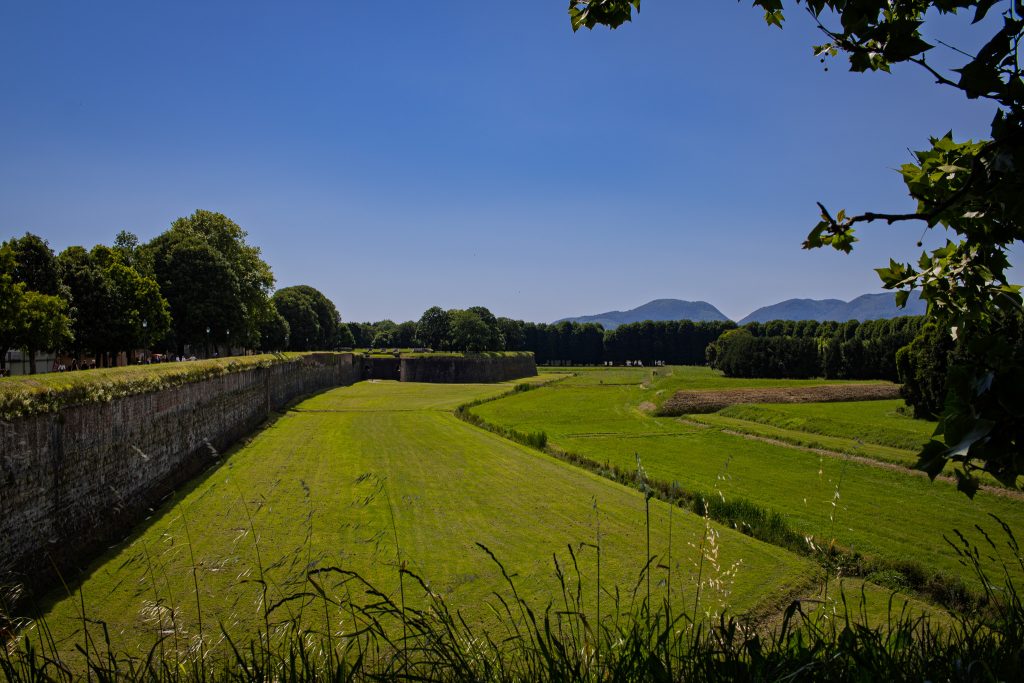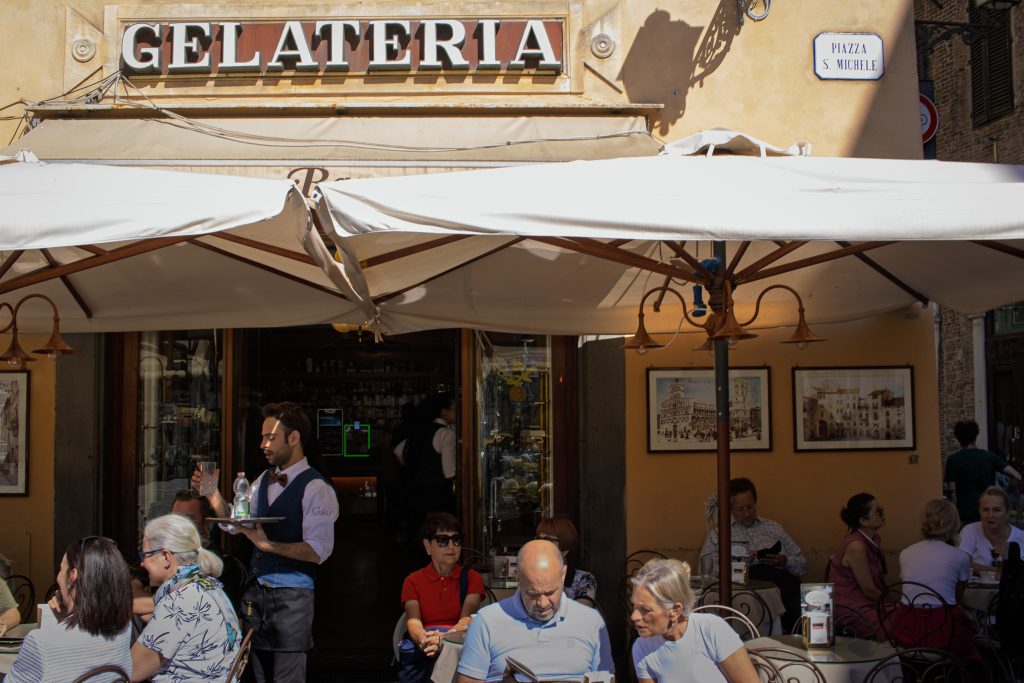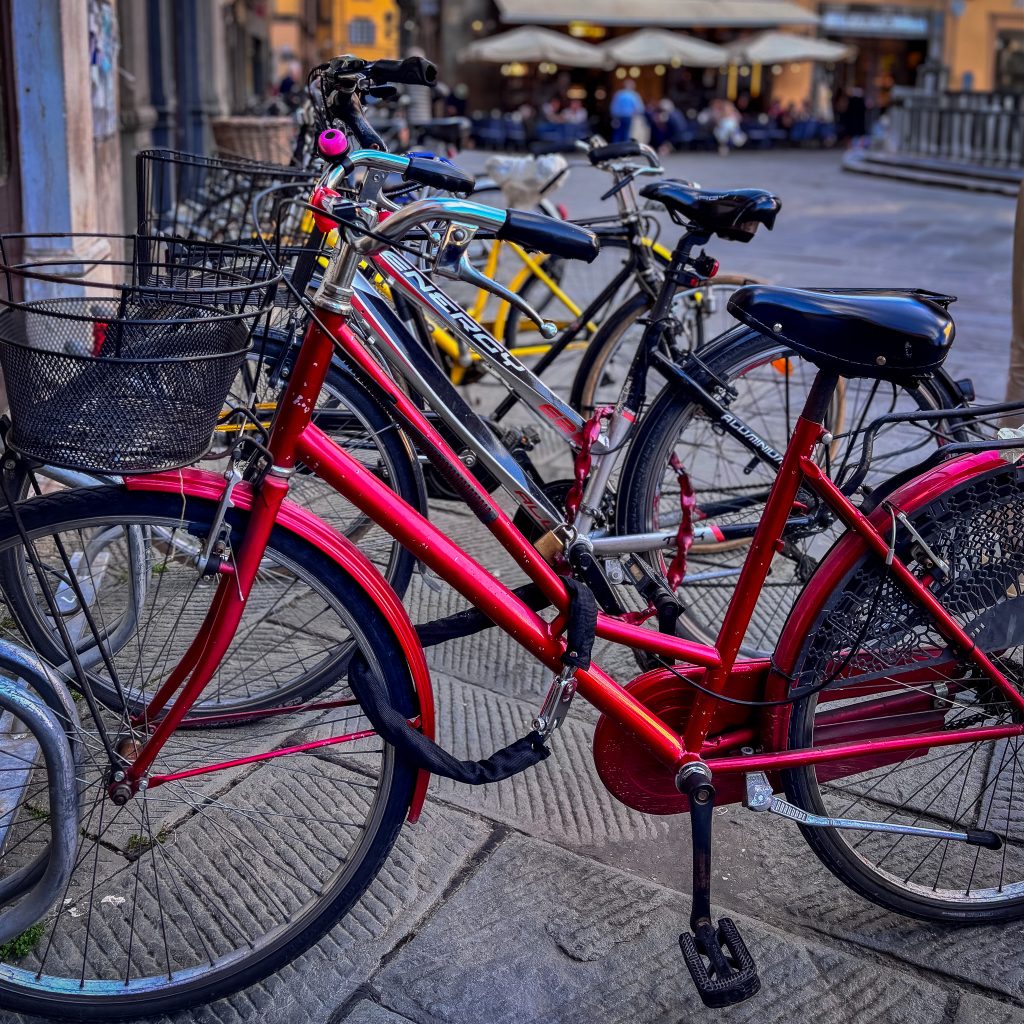Photographing Lucca: Bikes, Backstreets & Tuscan Light
Lucca was never about the big moment. No leaning towers, no jaw-drop cathedrals screaming for a wide lens. Instead, it’s a city of texture—old bricks, clean lines, soft light, and bikes that just keep coming. It’s slow in a way that feels intentional. Like it knows you’ll get the shot if you just hang out for a minute and stop trying so hard.
We didn’t have a list. We just started walking. Past shutters thrown open, laundry flapping in the breeze, pastry windows we didn’t even try to resist. We followed the city walls on foot, wandered down canals, ducked into tunnels for the shade and stayed for the light. Every few blocks, something else pulled us in: a book market, a half-lit alley, a red bike that looked like it posed itself. It wasn’t dramatic—it was just good.
We shot Lucca in late May, and the timing felt right. Warm but not punishing, with enough tourists to feel lively but not so many you had to wait your turn for a clean frame. Golden hour here hits differently—softer, longer, more spread out. From around 4:30pm onward, the city kind of glows. And if you’re lucky, that’s when the bikes come out, the shadows get sharp, and every corner starts looking like a film still.
The Northern City Walls

Best for: Wide landscapes, green geometry, and afternoon cyclists
If Lucca has a signature move, it’s the city walls—and this northern stretch is where everything clicks. Trees line the path like a natural colonnade. Below, rooftops and towers peek through gaps in the greenery. Above, it’s all soft sky and that afternoon light that makes even bad photos look decent. This is where you get your wide shots: long depth, leading lines, and locals riding past like they’ve been cast for a tourism campaign.
We came through here around 5pm and the shadows were perfect—long enough to stretch across the walkway, short enough not to blow out the highlights. The trick is to frame with intention. Use the shadows like lines. Let someone walk or cycle into the frame. Wait for a pop of red or yellow against all that green. You don’t need to stage it—Lucca will do the work if you’re patient.
Shoot wide (0.5x on iPhone works great), or move in and use the trees to layer your shot. And if you’re feeling cinematic, stand near one of the old lamp posts and wait for someone to ride past. It’s the kind of spot that makes you wish your camera had a soundtrack button.
Via del Fosso Canal View

Best for: Symmetry, old shutters, and that stillness you only find in places that don’t try too hard
If you want to shoot a version of Lucca that feels untouched, this is it. The canal along Via del Fosso runs quiet and slow, framed by peeling shutters, washed-out stucco, and the kind of soft reflections you only get when the water’s not in a rush. We found this view while crossing a small stone bridge near Via Santa Croce—and instantly stopped walking.
It’s a perfect symmetry shot. The kind where everything just lines up without needing a tripod or a Photoshop session. Buildings on both sides mirror each other in the water, with just enough imperfection to make it interesting. Look for repeating elements—shutters, balconies, clotheslines—and center them up. If you’re shooting on iPhone, turn on gridlines and use the center box to anchor the scene.
Late morning light worked best for us here—soft but bright enough to pull out texture. And if someone walks through the frame, let them. A bright shirt or a dog on a leash breaks the symmetry just enough to make the image feel alive.
The Tunnel Near Porta San Gervasio

Best for: Light-and-shadow shots, silhouettes, and texture
This one’s all about contrast. A tight stone tunnel, weathered walls, and that perfect streak of sunlight slicing through like it’s been doing it for centuries. It’s the kind of spot you almost miss—until you walk into it and see how the light hits. Then you’re stuck there for ten minutes waiting for someone interesting to walk by.
We hit this tunnel in late morning, and the light was just starting to blast in from one side. That’s your moment. Stand at the edge of the shadow and expose for the highlights—let the rest fall into black. You’ll get silhouettes, rim light, and those deep textures baked into the walls. If you’re shooting on iPhone, tap to meter on the brightest part and drag down to underexpose slightly. It’ll keep the shadows moody and the highlights clean.
It’s also a great spot for capturing motion blur. Set your phone to Live mode or use burst, and wait for someone to walk or cycle through the light strip. The setting does the hard work—you just have to be patient and still enough not to botch the shot.
La Piazzetta del Libro Book Market

Best for: Tight framing, warm tones, and character
Tucked under the trees and tucked even further from the main tourist drag, this little open-air book market feels like it was dropped here by someone with good taste and too many paperbacks. You’ve got old novels, vintage prints, faded maps, and handwritten signs—all spilling out from rickety tables under a green canopy. The vibe is pure Lucca: low-key, charming, and completely unbothered by your camera.
We found this by accident and almost didn’t shoot it because it felt too quiet. But then the light shifted, filtered through the leaves overhead, and everything turned this warm, dappled gold. That’s when it clicked. Crouch low, shoot through the leaves or between bookshelves, and let the messiness work in your favor. You’re not looking for symmetry here—you’re looking for soul.
It’s especially good if someone walks through the frame mid-shot: an older man with a shopping bag, a kid reaching for a comic, anything to give it life. This is also one of the few spots where a vertical orientation really sings—let the trees, tables, and shadows stack up in layers.
The Bakery Window on Via Santa Croce

Best for: Foodie shots, reflections, and street life texture
You’ll smell it before you see it. Somewhere along Via Santa Croce, this little bakery window pops out from the stone wall like a frame within a frame. Stacked with pastries, breads, and enough visual texture to make you forget you already had breakfast. It’s not styled. It’s not curated. It’s just real—and that’s what makes it shoot so well.
This one works best straight on. Walk up to the glass, find your reflection, and then shift until it disappears or becomes part of the composition. If you’ve got manual focus or tap-to-focus on your phone, lock onto the bread or signage. Let the background blur or let the reflections bring in the street—either way, you get layers.
Bonus if someone walks by while you’re shooting. You’ll catch their reflection ghosted over the food, adding depth and a little chaos. Don’t overthink it. The glass isn’t perfectly clean, the light’s not perfect—and that’s exactly the point. It feels lived-in. And that reads.
Piazza San Michele & the Gelateria Scene

Best for: Candid café culture, signage, and layered life
This is the kind of scene that only works because nothing about it is trying to be a scene. Piazza San Michele isn’t the flashiest square in Italy, but it’s one of those places that nails the basics: gelato, architecture, chairs scraped across stone, and that soft chaos of people doing absolutely nothing on purpose.
We grabbed a table here in the late afternoon and watched the light bounce between buildings and umbrellas like it was playing pinball. That’s the moment to shoot. Use the shadow lines from the umbrellas to divide your frame, then wait for someone to step into the light holding something colorful—ice cream, Aperol, whatever. This isn’t a clean shot. It’s a layered one. You want faces, signage, chairs, texture, movement.
Pro tip: stand back with your phone at chest height and pretend you’re texting. Half the time, people don’t even notice you’re shooting. The result? A real slice of Lucca life—quiet, unfiltered, and good enough to make you stay for a second scoop.
Bikes by the Church

Best for: Color contrast, pop of red, and urban detail
Sometimes it’s not the landmark that makes the shot—it’s what’s leaning against it. These red bikes were parked in a perfect little triangle near one of Lucca’s side-street churches, catching just enough sun to pop against the pale stone wall behind them. No setup, no editing magic. Just color doing its thing.
This is one of those frames that works because it’s quiet. There’s texture in the bricks, a soft wash of natural light, and that punch of saturated red that anchors the whole scene. If you’re shooting with a camera, go with a low f-stop like f/2.8 to isolate one bike and blur the rest. On iPhone, use Portrait mode from a few feet back to fake the depth.
It also works as a storytelling detail—especially when paired with a wider city shot. The bike is Lucca’s unofficial mascot, and this one feels like it’s been parked in that exact spot for a hundred years. Take your time with it. Wait for the light to shift or someone to walk past in the background. Sometimes the smallest scenes give you the most.
Looking Back
Lucca wasn’t the flashiest stop on our walk through Tuscany—but it stuck with us. Maybe it was the way the light hit the walls just right. Maybe it was the pop of a red bike against old stone. Or maybe it was the fact that we didn’t go in with a checklist—we just wandered, pointed the camera, and let the city show up. That’s the thing about walking: you don’t always know what you’re walking into, but sometimes, it turns out to be exactly what you needed.
Our time in Lucca was just one chapter in a much bigger journey—200+ miles on foot across Tuscany, from the Apennines to the sea. If this post resonated, you’ll love the full story in Walking Through Tuscany—a travel memoir filled with photo stops, real moments, and everything we didn’t see coming.








